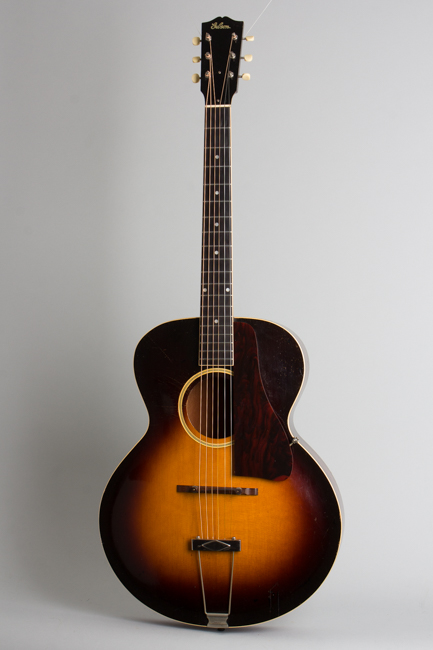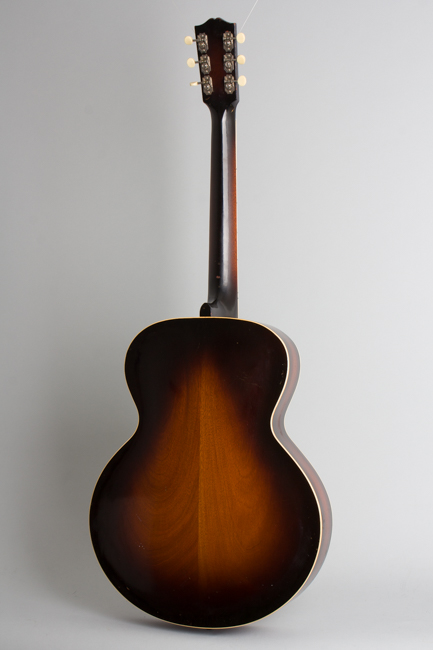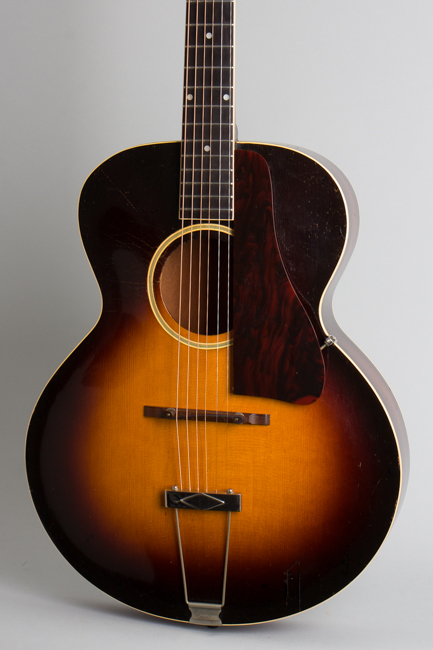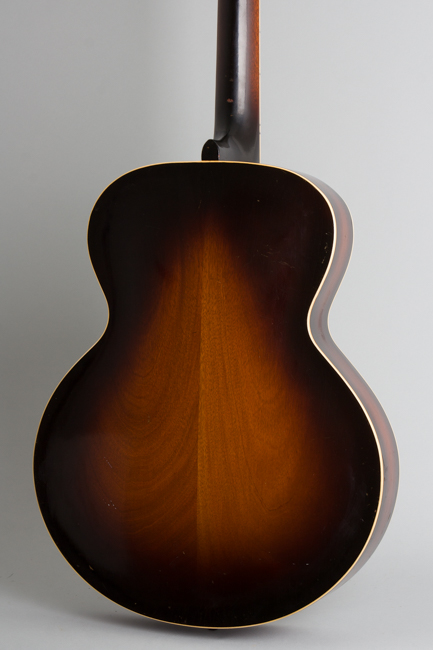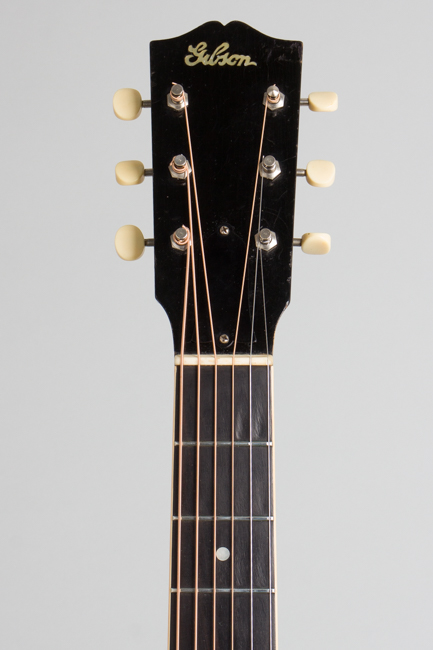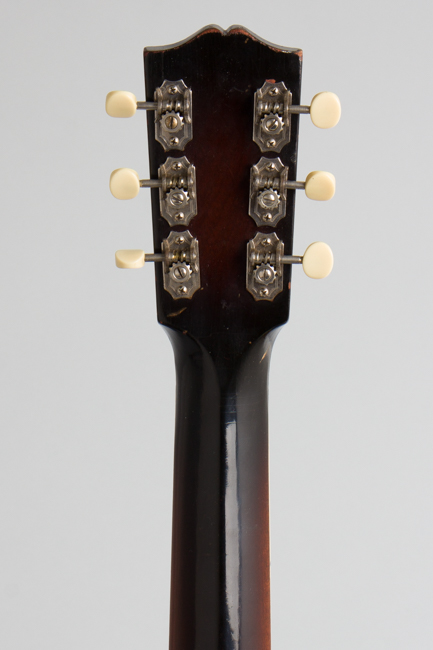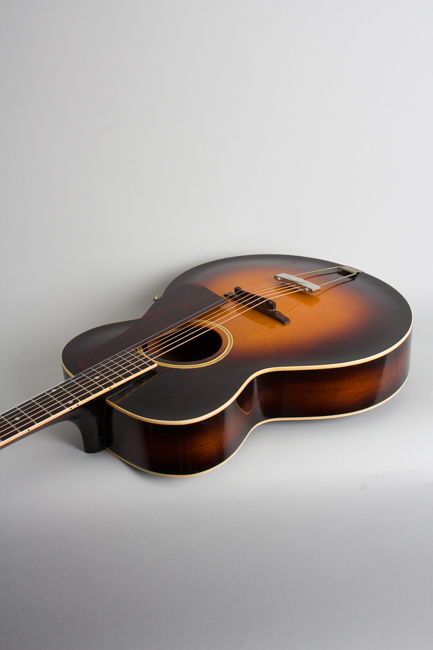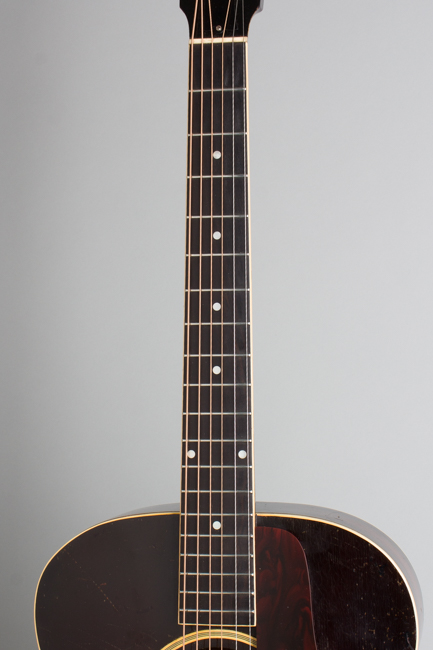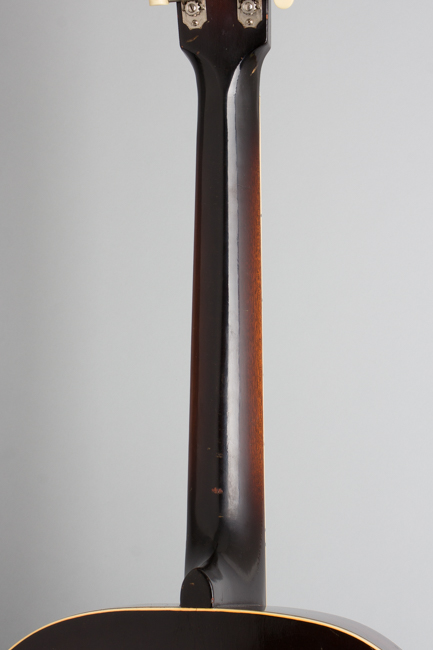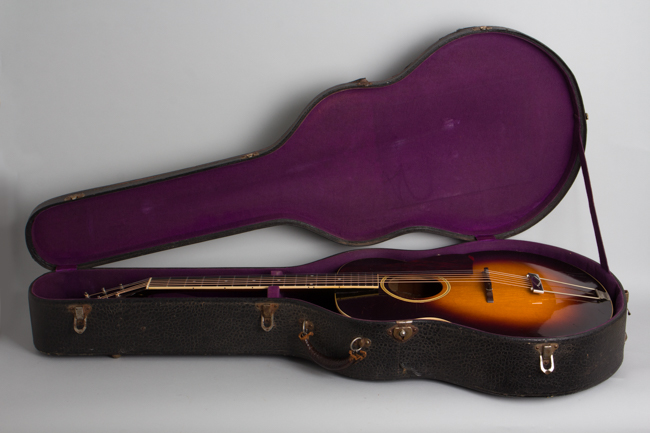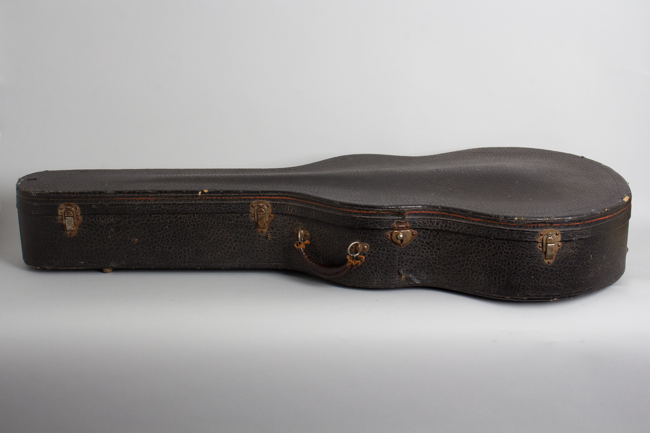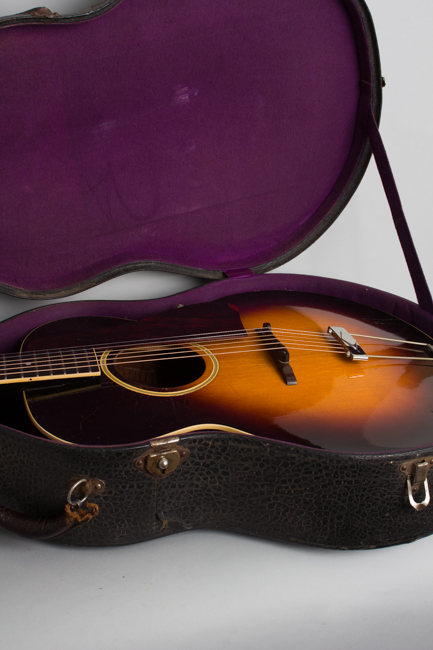Gibson L-75 Arch Top Acoustic Guitar (1939)
This item has been sold.
Item # 11187
Prices subject to change without notice.
Gibson L-75 Model Arch Top Acoustic Guitar (1939), made in Kalamazoo, Michigan, sunburst lacquer finish, mahogany back and sides, spruce top; mahogany neck with rosewood fingerboard, original black hard shell case.
At first glance, this guitar appears to be an early-mid 1930's L-4. Upon closer examination, however, the back and sides prove to be made of mahogany, while the L-4 is always listed as maple. What this is, IS a late 1930s L-75, the next model down the line, which was a 16" arch-top round hole mahogany guitar listing for $25 less at $75 (plus case). The L-4 was confusingly offered with either a round or F-hole top around 1937; after 1938 only the L-75 retained this configuration, and it would in turn be discontinued the next year. This is a fairly obscure model even many Gibson enthusiasts have never seen, and as it carries no style designation on the instrument is often mis-identified even when one appears!
This L-75 appears to date to that final production year of 1939. As a sub-$100 guitar these did not get an "Artist" white label with a serial number. The factory order number on the heel has faded to obscurity but appears to have a 1939-signifying "E" suffix. The early Kluson tuners are also characteristic of this year. Earlier L-75's have a sort of stickpin-like elongated diamond inlay on the headstock, but these final examples do not.
This is a 16" round-hole archtop with a carved top and back, finished in sunburst overall. The top and back are single bound, with multiple soundhole rings. The mahogany neck has a bound dot-inlaid fingerboard and a medium "V" profile typical of the period. The headstock is plain except for a pearl Gibson logo. By this time the L-50 was Gibson's popular $50 16" F-hole guitar, and the L-75 seemed to offer little advantage for the extra $25! This years L-75 marks the last gasp of Gibson's round-hole archtop guitars until the Howard Roberts models of the 1960s and '70s.
The roundhole archtop is generally perceived as a bit of a hybrid instrument, with a sound that has some of the character of both flattop and archtop guitars. This is a very good example of this obscure style, a fine sounding and playing L-75 with a surprising amount of power and a well-modulated tone.
Height is 40 1/4 in. (102.2 cm.), 16 in. (40.6 cm.) wide at lower bout, and 3 1/4 in. (8.3 cm.) in depth at side, taken at the end block. Scale length is 24 3/4 in. (629 mm.). Width of nut is 1 3/4 in. (44 mm.).
This is a very nice example overall, showing one small repair to the top but not too much actual wear. The original finish has some light dings, dents and scrapes scattered about but no really heavy wear. There is an ancient impact repair to the top, off the back edge on the lower treble bout. A piece of spruce looks to have been knocked loose and glued back in, with some light touch up. This is completely solid but visible. There are no other notable repairs.
The guitar appears all original except for an exact repro pickguard using the original bracket and possibly the tailpiece crossbar, which is the correct style but chrome plated. The original frets have some wear in the lower positions but playability is not affected. This unusual and interesting guitar is a very nice player and a neat Gibson rarity. It resides in a very clean original HSC. Overall Excellent Condition.
At first glance, this guitar appears to be an early-mid 1930's L-4. Upon closer examination, however, the back and sides prove to be made of mahogany, while the L-4 is always listed as maple. What this is, IS a late 1930s L-75, the next model down the line, which was a 16" arch-top round hole mahogany guitar listing for $25 less at $75 (plus case). The L-4 was confusingly offered with either a round or F-hole top around 1937; after 1938 only the L-75 retained this configuration, and it would in turn be discontinued the next year. This is a fairly obscure model even many Gibson enthusiasts have never seen, and as it carries no style designation on the instrument is often mis-identified even when one appears!
This L-75 appears to date to that final production year of 1939. As a sub-$100 guitar these did not get an "Artist" white label with a serial number. The factory order number on the heel has faded to obscurity but appears to have a 1939-signifying "E" suffix. The early Kluson tuners are also characteristic of this year. Earlier L-75's have a sort of stickpin-like elongated diamond inlay on the headstock, but these final examples do not.
This is a 16" round-hole archtop with a carved top and back, finished in sunburst overall. The top and back are single bound, with multiple soundhole rings. The mahogany neck has a bound dot-inlaid fingerboard and a medium "V" profile typical of the period. The headstock is plain except for a pearl Gibson logo. By this time the L-50 was Gibson's popular $50 16" F-hole guitar, and the L-75 seemed to offer little advantage for the extra $25! This years L-75 marks the last gasp of Gibson's round-hole archtop guitars until the Howard Roberts models of the 1960s and '70s.
The roundhole archtop is generally perceived as a bit of a hybrid instrument, with a sound that has some of the character of both flattop and archtop guitars. This is a very good example of this obscure style, a fine sounding and playing L-75 with a surprising amount of power and a well-modulated tone.
Height is 40 1/4 in. (102.2 cm.), 16 in. (40.6 cm.) wide at lower bout, and 3 1/4 in. (8.3 cm.) in depth at side, taken at the end block. Scale length is 24 3/4 in. (629 mm.). Width of nut is 1 3/4 in. (44 mm.).
This is a very nice example overall, showing one small repair to the top but not too much actual wear. The original finish has some light dings, dents and scrapes scattered about but no really heavy wear. There is an ancient impact repair to the top, off the back edge on the lower treble bout. A piece of spruce looks to have been knocked loose and glued back in, with some light touch up. This is completely solid but visible. There are no other notable repairs.
The guitar appears all original except for an exact repro pickguard using the original bracket and possibly the tailpiece crossbar, which is the correct style but chrome plated. The original frets have some wear in the lower positions but playability is not affected. This unusual and interesting guitar is a very nice player and a neat Gibson rarity. It resides in a very clean original HSC. Overall Excellent Condition.
